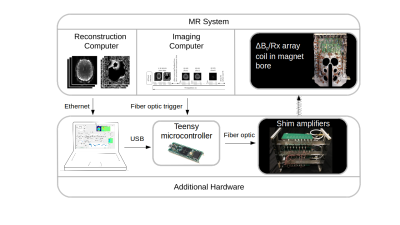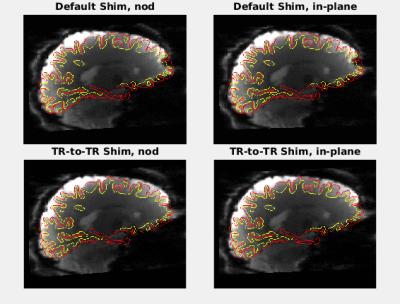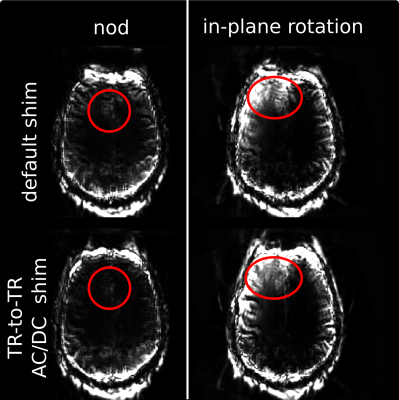0856
Real-time Motion Compensated ∆B0 Shimming with an AC/DC Shim Coil and Dual-Echo vNavs1Department of Electrical Engineering and Computer Science, Massachusetts Institute of Technology, Cambridge, MA, United States, 2A. A. Martinos Center for Biomedical Imaging, Massachusetts General Hospital, Charlestown, MA, United States, 3Department of Radiology, Harvard Medical School, Boston, MA, United States
Synopsis
Changes in subject position move susceptibility interfaces and therefore ∆B0 field patterns in the brain. We apply a prospective real time (TR-to-TR) shim updating scheme using dual echo EPI volume navigators to correct motion-induced changes in ∆B0 fields to reduce distortion in 2D EPI. Shim fields were produced by a 32 channel AC/DC head shim array. TR-to-TR shimming reduced EPI distortion in all head positions in in vivo experiments.
Introduction
Local multicoil shim arrays are a useful tool in mitigating ∆B 0 artifacts in a variety of imaging techniques by reducing static magnetic field inhomogeneity. Typical workflows optimize shim currents for a subject based on a single, start-of-scan-session fieldmap measurement using pre-measured coil field-profiles. Changes in subject position and respiration induce changes in ∆B 0 field that cannot be corrected by shimming currents calculated from the start-of-scan fieldmap.Methods for measuring changing magnetic field during a scan have been developed in parallel with technology for rapidly modifying applied shim fields. The field can be measured rapidly and accurately at discrete points in space using a field camera [1, 2] or across a volume at lower spatial and temporal resolution using a “shim navigator” [3, 4]. We previously implemented an EPI-based volumetric navigator with interleaved TEs that measures the field in 800 ms and demonstrated its use in spectroscopy sequences using the scanner’s frequency and linear gradients to adapt the shim field in real time [5, 6]. Actuating higher-order corrections is challenging because the scanner gradient hardware cannot be addressed in real time and is not eddy current compensated. Higher order shim inserts are an option [7] and in this work we integrated shim navigators with a 32-channel AC/DC shim array [8].
Due to long echo-spacing in the phase encoding direction, EPI exhibits large distortions in this direction. Traditionally distortions are corrected offline [9], but these methods may not recover distortions and signal dropouts in EPI series acquired during subject motion. In this work we use dual echo EPI volume navigators to correct motion-induced TR-to-TR changes in ∆B0 fields during 2D EPI acquisition by updating local multicoil shim array currents for whole-brain ∆B0 homogeneity shimming.
Methods
Tight scanner integration of vNav reconstruction, shim current calculation and shim driver hardware enabled TR-to-TR local multicoil shim updates as shown in figure 1. After vNav acquisition, the reconstruction computer sends magnitude and fieldmap data to an external shim-calculating laptop-computer. The laptop-computer then calculates updated local multicoil shim coefficients using a standard shim calculation processing pipeline [8].Once calculated, shim coefficients are transferred to shim driver hardware [10] over a USB connection. The shim driver then waits for fiber-optic trigger signals from the imaging computer to update current outputs. Figure 2 shows a timing diagram of the MR protocol.
In vivo experiments were performed on one human subject on a 3T Prisma scaner. vNavs were acquired at 8 mm iso, 32x32x32 matrix, TE1 = 6.2 ms, TE2 = 8.6 ms, TR = 16 ms. 2D EPI acquired at 2.3 mm iso, 96x96 matrix, 60 slices, TE = 30 ms, TR = 7.56 s. Shim current calculation consistently completed 0.8 s before due. An MEMPRAGE (1mm iso, 256x256x256 matrix, PAT3) was acquired as a structural reference. All measurements were acquired and shimmed with the 32 channel AC/DC RFRx and ∆B0 shim array [8].
Motion shimming experiments were conducted with in-plane left-right rotation and out-of-plane nodding motions. The subject was instructed to move to, and hold desired position for six TRs. Shim settings were alternated each TR between applying the TR-to-TR correction and inactive to match subject-position for shimmed and baseline acquisitions.
EPI images were registered to the anatomical reference using BBRegister [11]. Shim effectiveness is assessed by the BBRegister cost function. Each registered series was then registered to each other with MCFLIRT [12]. MCFLIRT variance maps were used to evaluate inconsistency in distortion.
Though already registered to the anatomical reference, co-registration determined where the initial registration struggled with motion-induced distortion changes as evaluated by variance maps
Results
Figure 3 shows the BBRegister cost function for the default shim and TR-to-TR AC/DC shim series in both the nodding and within-axial-plane motion experiments. In all cases TR-to-TR shimming reduced BBRegister cost of registration. This shows reduced TR-to-TR shimming distortion as evaluated by better match of the EPI series to the anatomical reference gray-white surface boundaries.An animation of representative registered images from each time series is shown in figure .4. We can see reduced distortion through the use of TR-to-TR shimming particularly in the nod experiment. Inferior-located distortions not corrected by the TR-to-TR shim may be due to poor brain-masking.
Figure 5 shows coregistration variance maps produced by MCFLIRT. Red circles highlight the prefrontal cortex where TR-to-TR AC/DC shimming reduced differences in co-registered images. Additionally the anterior edge of the TR-to-TR shimmed nod experiment shows significantly improved geometric fidelity.
Discussion
We have implemented a real time (TR-to-TR) whole-brain ∆B0 shim updating system using 2TE vNav fieldmapping. EPI distortion was reduced and anatomical consistency between head-positions was improved during both head nodding and in-plane rotation. To use this method, EPI TRs must be increased to allow for the latency of the shim calculation. Through calculation pipelining and optimization, overhead may be reduced. Improved shim performance may be achieved by performing slice-by-slice TR-to-TR shimming and may be combined at no cost with vNav-based prospective motion correction.Our TR-to-TR shim method may be applied to other shim-sensitive, motion-plagued measurements with MR Spectroscopy being a promising candidate.
Acknowledgements
The authors the following funding sources: NIH R01CA255479l NIH R01HD085813, R01HD03578, R01HD099846, R21EB029641, Next Generation Program: Skoltech – MIT Joint Projects.
We acknowledge the engineering work of Dylan Tisdall and Aaron Hess who contributed to the 2TE vNav infrastructure used in this study, Thomas Witzel for contributions to realtime shimming and scanner interfacing, and Danny Park and Jon Polimeni for providing the EPI sequence.
References
[1] Benjamin E Dietrich, David O Brunner, Bertram J Wilm, Christoph Barmet, Simon Gross, Lars Kasper, Maximilian Haeberlin, Thomas Schmid, S Johanna Vannesjo, and Klaas P Pruessmann. A field camera for mr sequence monitoring and system analysis. Magnetic resonance in medicine, 75(4):1831–1840, 2016.
[2] Alexander Aranovitch, Maximilian Haeberlin, Simon Gross, Benjamin E Dietrich, Jonas Reber, Thomas Schmid, and Klaas P Pruessmann. Motion detection with nmr markers using real-time field tracking in the laboratory frame. Magnetic resonance in medicine,84(1):89–102, 2020.
[3] Aaron T Hess, M Dylan Tisdall, Ovidiu C Andronesi, Ernesta M Meintjes, and André J Wvan der Kouwe. Real-time motion and b0 corrected single voxel spectroscopy using volumetric navigators. Magnetic resonance in medicine, 66(2):314–323, 2011.
[4] Brian Keating and Thomas Ernst. Real-time dynamic frequency and shim correction for single-voxel magnetic resonance spectroscopy. Magnetic resonance in medicine, 68(5):1339–1345, 2012.
[5] Aaron T Hess, Ovidiu C Andronesi, M Dylan Tisdall, A Gregory Sorensen, André J Wvan der Kouwe, and Ernesta M Meintjes. Real-time motion and b0 correction for localized adiabatic selective refocusing (laser) mrsi using echo planar imaging volumetric navigators. NMR in Biomedicine, 25(2):347–358, 2012.
[6] Wolfgang Bogner, Aaron T Hess, Borjan Gagoski, M Dylan Tisdall, Andre J W van derKouwe, Siegfried Trattnig, Bruce Rosen, and Ovidiu C Andronesi. Real-time motion-and-b0-correction for laser-localized spiral-accelerated 3d-mrsi of the brain at 3 t. Neuroimage,88:22–31, 2014.
[7] Ali Aghaeifar, Christian Mirkes, Jonas Bause, Theodor Steffen, Nikolai Avdievitch, Anke Henning, and Klaus Scheffler. Dynamic b0 shimming of the human brain at 9.4 t with a16-channel multi-coil shim setup. Magnetic resonance in medicine, 80(4):1714–1725, 2018.
[8] Jason P Stockmann, Thomas Witzel, Boris Keil, Jonathan R Polimeni, Azma Mareyam,Cristen LaPierre, Kawin Setsompop, and Lawrence L Wald. A 32-channel combined rf and b0 shim array for 3t brain imaging. Magnetic resonance in medicine, 75(1):441–451, 2016.
[9] Jesper LR Andersson, Stefan Skare, and John Ashburner. How to correct susceptibility distortions in spin-echo echo-planar images: application to diffusion tensor imaging. Neuroimage, 20(2):870–888, 2003.
[10] N Arango, J Stockmann, T Witzel, L Wald, and J. White. Open-source acquisition-speed slice-by-slice controller for 32 coil b0 shimming. ISMRM, 2682, 2017.
[11] Mark Jenkinson, Christian F Beckmann, Timothy EJ Behrens, Mark W Woolrich, and Stephen M Smith. Fsl. Neuroimage, 62(2):782–790, 2012.
[12] Mark Jenkinson, Peter Bannister, Michael Brady, and Stephen Smith. Improved optimization for the robust and accurate linear registration and motion correction of brain images.Neuroimage, 17(2):825–841, 2002.
Figures




